Texas, with its vast and varied landscape, is home to many lakes, rivers, and other aquatic environments. These water bodies provide essential habitats for various plant and animal species, supporting a rich and diverse ecosystem.
From the meandering Rio Grande to the picturesque Caddo Lake, Texas’s aquatic ecosystems offer breathtaking natural beauty and recreational opportunities for residents and visitors alike.
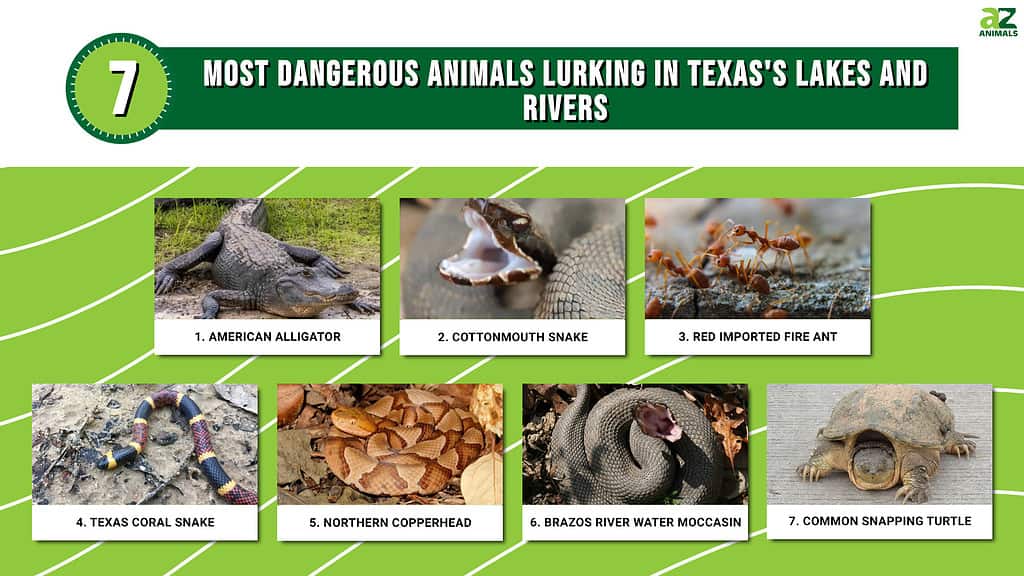
While these ecosystems are undoubtedly captivating, it’s crucial to recognize that they can also harbor dangers.
Texas’ waterways are inhabited by several animals that, if encountered under the wrong circumstances, can pose a threat to human safety. Understanding these potential dangers and knowing how to avoid or deal with them is essential for anyone venturing into Texas’s lakes and rivers.
Today, we discover the seven most dangerous animals found in Texas’s lakes and rivers.
1. American Alligator (Alligator mississippiensis)
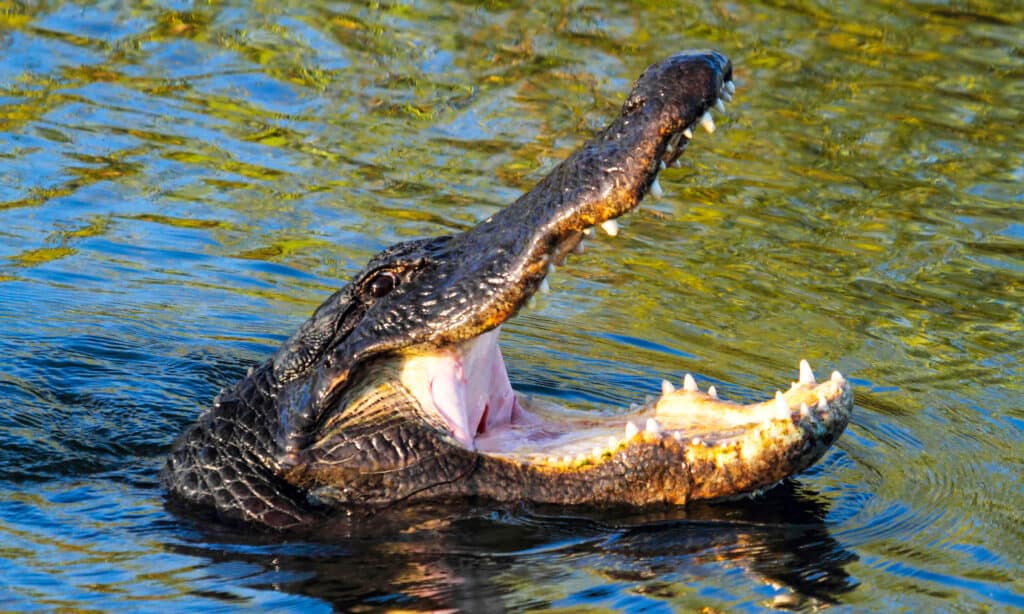
The American alligator is an apex predator found in many lakes and rivers in Texas.
©Steve Byland/Shutterstock.com
As one of the most iconic and potentially dangerous inhabitants of Texas’s lakes and rivers, the American alligator (Alligator mississippiensis) warrants special attention for those venturing into the state’s aquatic environments.
Description and Habitat
The American alligator is a large reptile that inhabits various aquatic habitats, including lakes, rivers, swamps, and marshes.
These apex predators can grow up to 15 feet long and weigh over 1,000 pounds.
Their dark coloration and formidable size make them easily recognizable. Meanwhile, their powerful jaws and sharp teeth enable them to prey on fish, turtles, birds, and mammals.
Reasons for Their Danger to Humans
Although alligators are generally not aggressive to humans, they can become dangerous if they feel threatened, or cornered, or if humans approach their nests.
Alligator attacks on humans are relatively rare, but when they occur, they can result in severe injury or even death.
Additionally, alligators occasionally mistake small dogs or pets for prey, leading to tragic encounters.
Tips for Avoiding Encounters
To minimize the risk of alligator encounters, it is crucial to follow some simple safety guidelines:
- Keep a safe distance. Don’t approach alligators or their nests. Give them ample space to move and avoid feeling threatened.
- Don’t feed alligators. Feeding alligators is illegal and dangerous, as it encourages them to associate humans with food, increasing the likelihood of an encounter.
- Supervise children and pets. Always keep a close watch on children and pets near water bodies where alligators may be present.
- Be cautious during alligator mating season. Alligators are more active and aggressive during mating season, usually between April and June. Therefore, be extra vigilant during this time.
2. Cottonmouth Snake (Agkistrodon piscivorus)

Cottonmouth snakes are a semi-aquatic venomous species commonly found in wetland environments throughout Texas.
©Jay Ondreicka/Shutterstock.com
Cottonmouth snakes, also known as water moccasins, are a venomous species commonly found in Texas’s lakes and rivers.
Description and Habitat
Cottonmouth snakes are semi-aquatic pit vipers that inhabit various wetland environments, including lakes, rivers, swamps, and marshes.
These snakes can grow up to 6 feet long. Their dark, often banded coloration helps them blend into their surroundings. Cottonmouths get their name from the white, cotton-like lining of their mouths, which they display when threatened.
Venom Toxicity and Risks
Cottonmouth snakes possess a potent hemotoxic venom that can cause severe pain, swelling, and tissue damage if left untreated.
While fatalities from cottonmouth bites are rare, the consequences of a bite can be serious. Therefore, medical attention should be sought immediately if bitten.
These snakes are generally not aggressive to humans but will bite if they feel threatened or provoked.
Tips for Identification and Avoiding Bites
To reduce the risk of cottonmouth encounters and bites, consider the following tips:
- Learn to identify cottonmouths. Familiarize yourself with their distinctive appearance, including their triangular-shaped head, dark coloration, and white mouth lining.
- Stay on designated paths. When hiking or walking near waterways, stay on well-trodden paths and avoid areas with dense vegetation where cottonmouths may be hiding.
- Exercise caution when near water. Cottonmouths are often found near or in water, so be cautious when wading, fishing, or engaging in other water-based activities.
- Don’t provoke or handle wild snakes. If you encounter a cottonmouth or any other snake, maintain a safe distance, and avoid provoking or attempting to handle it.
3. Red Imported Fire Ant (Solenopsis invicta)

Red imported fire ants are a dangerous and invasive species found in aquatic environments throughout the southern United States.
©NOTE OMG/Shutterstock.com
These ants are an invasive species that have established themselves in Texas’s aquatic environments, posing a potential threat to both humans and native wildlife.
Description and Habitat
Red imported fire ants are small, reddish-brown ants that typically measure 0.125-0.25 inches long. They’re native to South America but have become widespread throughout the southern United States, including Texas.
Fire ants build large, dome-shaped mounds near water bodies like lakes, rivers, and ponds. They’re also found in urban and agricultural areas.
Reasons for Their Danger to Humans
Fire ants are considered dangerous due to their aggressive behavior and painful stings. They swarm and attack the perceived threat when their nests are disturbed, injecting venom through their stingers. The venom causes a burning sensation. The stings can result in painful, itchy, and swollen pustules. Some individuals may experience severe allergic reactions to fire ant stings, which can be life-threatening if not treated promptly.
Tips for Avoiding Fire Ant Encounters
To minimize the risk of fire ant encounters and stings, consider the following tips:
- Learn to identify fire ant mounds. Familiarize yourself with the appearance of fire ant mounds and avoid disturbing them.
- Be cautious when near water. Fire ants are often found near water bodies, so be extra vigilant when engaging in water-based activities, such as swimming, fishing, or picnicking.
- Wear protective clothing. Wear closed-toe shoes, long pants, and socks to minimize skin exposure and reduce the risk of stings.
- Seek immediate medical attention if necessary. For example, seek medical attention immediately if you experience a severe allergic reaction to fire ant stings.
By being aware of the potential dangers posed by red imported fire ants and following these safety tips, you can safely enjoy the lakes and rivers in Texas without unnecessary concern.
4. Texas Coral Snake (Micrurus tener)
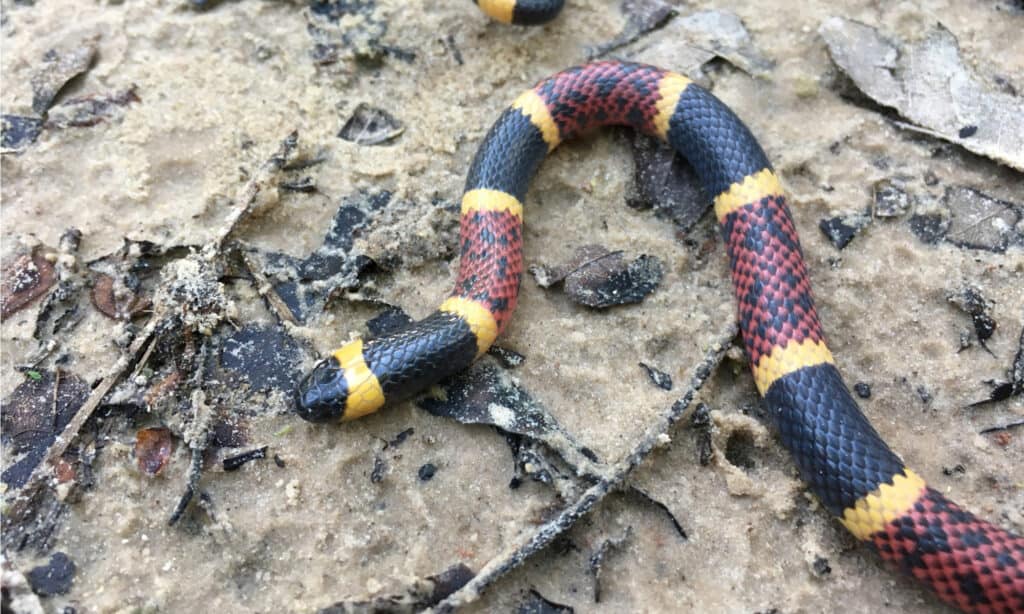
Texas coral snakes are recognized by their alternating red, yellow, and black bands.
©Joe Farah/Shutterstock.com
This snake is a venomous species found in various parts of Texas, including areas near lakes and rivers.
Description and Habitat
Texas coral snakes are characterized by their vibrant coloration, featuring alternating red, yellow, and black bands.
They typically grow up to 3 feet long and have a slender body and rounded head. These secretive snakes inhabit various environments, such as:
- Woodlands
- Grasslands
- Areas near water bodies
They feed primarily on other snakes and small lizards.
Venom Toxicity and Risks
Texas coral snakes possess a potent neurotoxic venom that can cause severe symptoms, including:
- Difficulty in breathing
- Muscle paralysis
- Death in extreme cases
While bites from Texas coral snakes are relatively rare due to their elusive nature and preference to avoid confrontation, they can be dangerous if not treated promptly.
Tips for Identification and Avoiding Bites
To reduce the risk of coral snake encounters and bites, consider the following tips:
- Learn to identify Texas coral snakes. Familiarize yourself with their distinctive coloration to distinguish them from non-venomous mimic species.
- Be cautious in snake habitats. When near water or in other potential snake habitats, be aware of your surroundings and watch where you step or place your hands.
- Don’t handle wild snakes. If you encounter a coral snake or any other snake, maintain a safe distance and avoid attempting to handle it.
- Seek immediate medical attention for bites. If bitten by a Texas coral snake, remain as calm as possible, immobilize the affected area, and seek medical attention immediately.
5. Northern Copperhead (Agkistrodon contortrix)
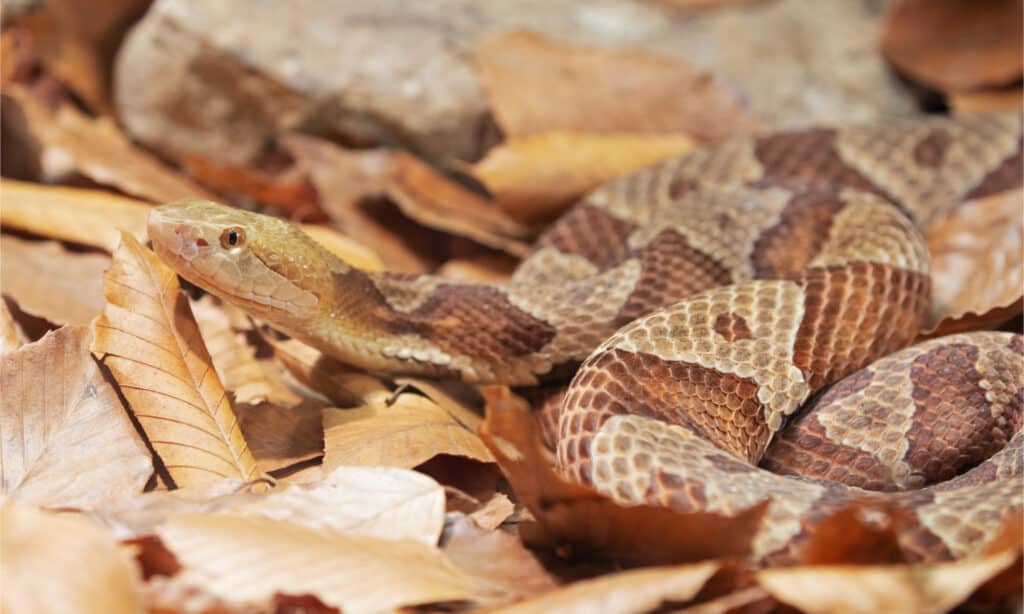
Northern copperhead snakes possess a hemotoxic venom that is dangerous to humans.
©DnDavis/Shutterstock.com
The northern copperhead is a venomous snake found in various Texas habitats, including areas near lakes and rivers.
Description and Habitat
Northern copperheads are medium-sized snakes that can grow up to 3 feet long. They’re characterized by their distinct copper-colored head and a pattern of chestnut or reddish-brown hourglass-shaped bands on a lighter background.
Copperheads inhabit various environments, such as woodlands, rocky areas, and wetland edges. They feed on rodents, amphibians, and other small animals.
Venom Toxicity and Risks
Copperheads possess a hemotoxic venom that can cause:
- Pain
- Swelling
- Tissue damage if left untreated
Although their venom is less potent than that of some other venomous snake species in Texas, copperhead bites can still be dangerous, particularly for:
- Young children
- The elderly
- Those with compromised immune systems
Copperheads are generally not aggressive to humans, but they will bite if they feel threatened or provoked.
Tips for Identification and Avoiding Bites
To reduce the risk of copperhead encounters and bites, consider the following tips:
- Learn to identify northern copperheads. Familiarize yourself with their distinctive appearance, including their copper-colored head and hourglass-shaped bands.
- Be cautious in snake habitats. When near water or in other potential snake habitats, be aware of your surroundings and watch where you step or place your hands.
- Exercise caution at dusk and dawn. Copperheads are most active during the early morning and late afternoon hours, so be particularly cautious during these times.
- Don’t provoke or handle wild snakes. If you encounter a copperhead or any other snake, maintain a safe distance and avoid provoking or attempting to handle it.
6. Brazos River Water Moccasin (Agkistrodon piscivorus leucostoma)

The venomous Brazos River water moccasin has a thick, heavy body and a dark, olive-brown coloration.
©Ryan M. Bolton/Shutterstock.com
The Brazos River water moccasin, also known as the western cottonmouth, is a venomous snake species found in Texas, particularly in areas near the Brazos River and its tributaries.
Description and Habitat
The Brazos River water moccasin is a medium-sized snake, usually reaching 2-4 feet long. They’re characterized by their thick, heavy bodies, triangular heads, and dark, olive-brown coloration with faint banding.
These semi-aquatic snakes inhabit various environments near water sources, such as swamps, marshes, and riverbanks, where they feed on fish, amphibians, and other small animals.
Venom Toxicity and Risks
Water moccasins possess a hemotoxic venom that can cause pain, swelling, and tissue damage.
Although their venom isn’t as potent as that of some other venomous snake species in Texas, water moccasin bites can still be dangerous and require prompt medical attention.
Water moccasins are generally not aggressive to humans but will bite if threatened or provoked.
Tips for Avoiding Bites
To reduce the risk of Brazos River water moccasin encounters and bites, consider the following tips:
- Learn to identify water moccasins. Familiarize yourself with their distinctive appearance, including their thick bodies, triangular heads, and dark coloration.
- Be cautious in snake habitats. When near water or in other potential snake habitats, be aware of your surroundings and watch where you step or place your hands.
- Avoid approaching or handling wild snakes. If you encounter a water moccasin or any other snake, maintain a safe distance and avoid provoking or attempting to handle it.
- Seek immediate medical attention for bites. If bitten by a Brazos River water moccasin, remain as calm as possible, immobilize the affected area, and seek medical attention immediately.
7. Common Snapping Turtles (Chelydra serpentina)
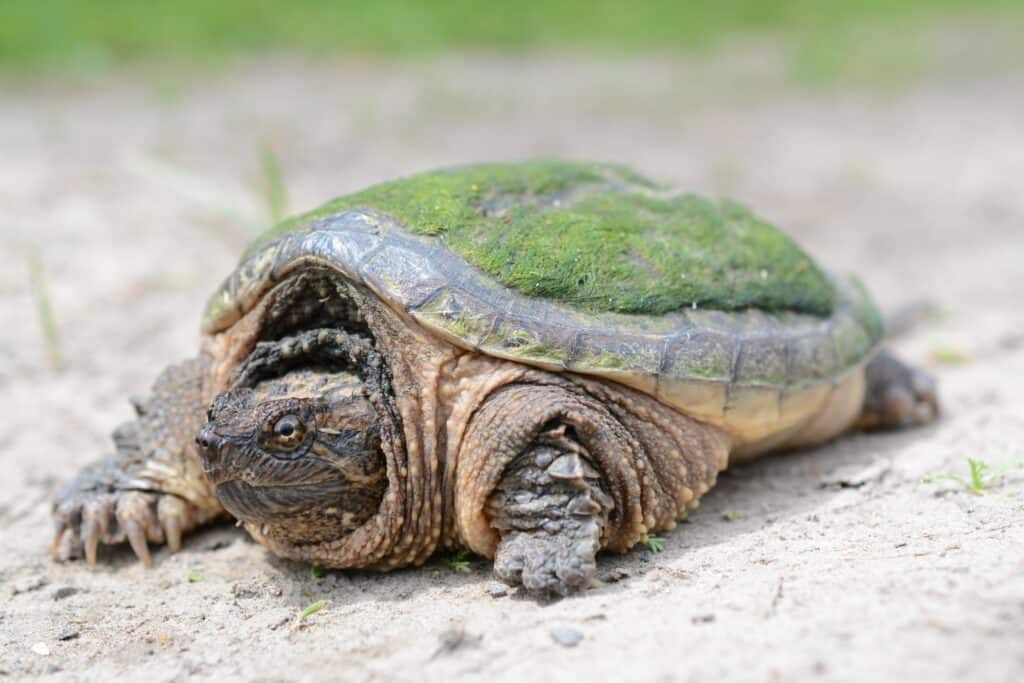
While snapping turtles aren’t typically aggressive to humans, they can deliver powerful bites that can cause severe injury.
©Trevor Meunier/Shutterstock.com
This is a large freshwater turtle that can pose a threat to native wildlife and, in some cases, humans in Texas’s lakes and rivers.
Description and Habitat
Common snapping turtles are characterized by their large, robust shells, which can measure up to 18 inches long, and their powerful, beak-like jaws.
These turtles can weigh up to 45 lbs. They’re easily identified by their thick, muscular tails, almost as long as their shells. Snapping turtles inhabit various freshwater habitats, such as:
- Lakes
- Rivers
- Ponds
- Swamps
They feed on fish, amphibians, invertebrates, and occasionally small mammals and birds.
Ecological Impact and Risks to Humans
Common snapping turtles can have a significant ecological impact on native species due to their voracious appetites and aggressive behavior.
They can outcompete and prey upon native turtle species, disrupting the local ecosystem’s balance. In addition, while snapping turtles aren’t typically aggressive to humans, they can become defensive if cornered or provoked, delivering powerful bites that can cause severe injury.
Tips for Identification and Avoiding Encounters
To reduce the risk of snapping turtle encounters and potential injuries, consider the following tips:
- Learn to identify common snapping turtles. Familiarize yourself with their distinctive appearance, including their large shells, powerful jaws, and muscular tails.
- Be cautious in turtle habitats. When near water or in other potential turtle habitats, be aware of your surroundings and watch for signs of snapping turtles.
- Don’t approach or handle wild turtles. If you encounter a snapping turtle, maintain a safe distance and avoid attempting to handle it, as their bites can be extremely powerful.
- Report sightings of invasive turtles. If you come across common snapping turtles in areas where they aren’t native, report your findings to the appropriate local or state authorities.
Key Takeaways
Texas is home to diverse wildlife, including many potentially dangerous species that inhabit the state’s lakes and rivers.
By familiarizing yourself with these animals’ characteristics, behaviors, and risks, you can safely navigate and appreciate the natural beauty of Texas’s aquatic environments.
Remember to exercise caution, respect the wildlife, and follow safety tips to minimize the risk of negative encounters.
The photo featured at the top of this post is © User: Achim Raschka, U.S. Fish and Wildlife Service, Public domain, via Wikimedia Commons – License / Original
Thank you for reading! Have some feedback for us? Contact the AZ Animals editorial team.






